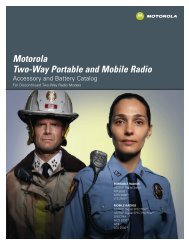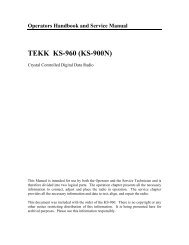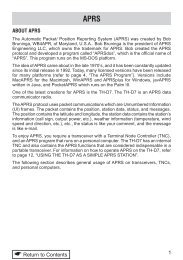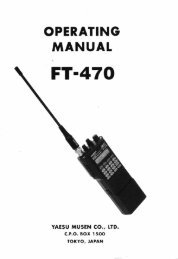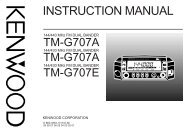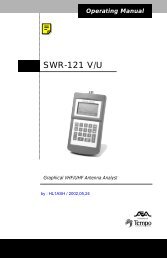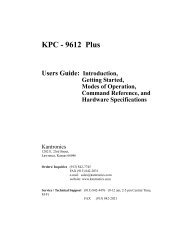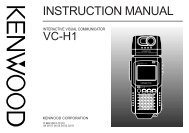SignaLink SL-1+ Installation & Operation Manual - Tigertronics
SignaLink SL-1+ Installation & Operation Manual - Tigertronics
SignaLink SL-1+ Installation & Operation Manual - Tigertronics
You also want an ePaper? Increase the reach of your titles
YUMPU automatically turns print PDFs into web optimized ePapers that Google loves.
on the microphone or Accessory Port connector of most<br />
radios. If Accessory Voltage is not available from the radio,<br />
then power can be supplied through a 2.1mm power jack on<br />
the rear of the unit.<br />
Powering From Your Radio – To determine if the<br />
<strong>SignaLink</strong> can be powered from your radio, you will need to<br />
check the “pin-out” of the radio connector that you are going<br />
to attach the <strong>SignaLink</strong> to (Mic, Data, Accessory, etc.). This<br />
information can be found in your radio Operators <strong>Manual</strong>.<br />
Most radios have a small amount of power available on the<br />
mic jack (typically 8v @ 10ma) for microphone accessories<br />
(DTMF pad, LEDs, etc.). Power is also sometimes available<br />
on the Data or Accessory port. If your manual shows that<br />
this voltage is available, then you can skip now to the<br />
“Connecting The Radio” section of this manual. That<br />
section will cover making the actual power connection.<br />
If power is not available on the radio connector you are<br />
using, then you have a couple of other easy options for<br />
powering the <strong>SignaLink</strong>. The first option would be to obtain<br />
power from whatever 12 volt supply powers your radio. To<br />
do this you will need to make a short cable from that power<br />
supply to the external power jack on the back of the<br />
<strong>SignaLink</strong>. Note that you might also be able to obtain 12-<br />
volt power from an Accessory Voltage connector on the back<br />
of the radio (check your radio manual). The external power<br />
jack on the <strong>SignaLink</strong> requires a standard 2.1mm/5.5mm<br />
power plug. This plug has been included with the <strong>SignaLink</strong><br />
for your convenience. You will need to wire the plug to your<br />
power supply in the appropriate manner. The polarity of the<br />
plug should be center positive. Be sure to wire the plug<br />
with the correct polarity and be sure to install a fuse in the<br />
line for safety. For maximum protection, we recommend<br />
that you fuse BOTH the positive and negative power lines<br />
with a low current (250 ma or less) “fast blow” fuse.<br />
The second option for powering the <strong>SignaLink</strong> is to use a<br />
Wall Transformer. This is the quick and easy solution but it<br />
does require an outlet. If you choose this option, you will<br />
need to select a transformer with an appropriate rating. A<br />
common problem in selecting wall transformers is that they<br />
almost always put out more voltage than you expect. This is<br />
because they are rated for output voltage at a specific load<br />
current. If the load on the transformer is below the rated<br />
load, then the voltage output will be higher than the rated<br />
output. Under a light load, it is not uncommon for wall<br />
transformers to provide twice their rated output voltage!<br />
This means that a typical 12 volt transformer might put out<br />
as much as 25 volts under little or no load, which would<br />
exceed the <strong>SignaLink</strong> input voltage ratings. Because of the<br />
very light load (13ma) provided by the <strong>SignaLink</strong>, you will<br />
need to select a transformer with a rated voltage well under<br />
12 volts. We would recommend a 6 volt transformer with a<br />
low current rating. Below are some transformer sources that<br />
are appropriate.<br />
Radio Shack P/N 273-1758 (6v 300ma). You will also need<br />
the 2.1mm (5.5mm OD) adapter plug P/N 273-1716.<br />
Mouser Electronics (1-800-346-6873): P/N 412-106054.<br />
(6v 500ma). Mouser also has a 9 Volt 200ma wall<br />
transformer (P/N: 412-109024) that will work.<br />
Digikey (1-800-344-4539): P/N DPD090020-P-5 or<br />
DPD090020-P5-TC. These are both 9 Volt 200 ma units<br />
that will work fine.<br />
- CONNECTING THE SOUND CARD -<br />
The <strong>SignaLink</strong> connects to the sound card through two<br />
shielded audio cables with 3.5mm stereo connectors.<br />
Connect one cable from the jack labeled “Computer –<br />
SPKR” on the <strong>SignaLink</strong> to the jack labeled “Speaker<br />
Output” on your sound card. The Speaker Output jack will<br />
be Green if color-coded. Connect the other cable from the<br />
jack labeled “Computer – MIC” on the <strong>SignaLink</strong> to the<br />
“Microphone Input” jack on the sound card. This jack will<br />
be Pink or Red if color-coded.<br />
Note that if you normally have speakers connected to your<br />
sound card and want to keep them connected while the<br />
<strong>SignaLink</strong> is installed, then you will need to use a stereo “Y”<br />
adapter cable on the sound card output. We have supplied a<br />
“Y” adapter in our optional Cable Accessory Kit for your<br />
convenience. We do NOT recommend the use of a “Y”<br />
adapter unless you are using “amplified” (powered)<br />
speakers. Conventional speakers often times cause slight<br />
overloading of the sound card output, which can reduce the<br />
signal level available to the <strong>SignaLink</strong> and produce minor<br />
distortion. This distortion is generally not noticeable to your<br />
ear but can greatly impact the quality of some digital<br />
modulation signals like PSK-31. It is generally preferred not<br />
to leave the speakers connected unless they can be switched<br />
OFF when not in use. You will find most of the digital<br />
modulation schemes very loud and very annoying anyway!<br />
- CONNECTING THE RADIO -<br />
CAUTION – Before connecting the <strong>SignaLink</strong> to your radio,<br />
read this entire section thoroughly. Both the <strong>SignaLink</strong> and<br />
your radio can be damaged by improper installation.<br />
The <strong>SignaLink</strong> attaches to the radio through an 8-pin RJ-45<br />
connector located on the rear of the unit. A radio cable with<br />
the appropriate connector for your radio was supplied with<br />
the <strong>SignaLink</strong> for this purpose. One end of this cable plugs<br />
into the <strong>SignaLink</strong>’s “RADIO” connector, and the other end<br />
plugs into the radio’s Mic, Data, or Accessory Port<br />
connector. This cable brings all of the radio’s signal lines<br />
into the <strong>SignaLink</strong>, so that you can connect to any line that is<br />
required (see note below on connectors with more than eight<br />
pins). The <strong>SignaLink</strong> uses the radio’s Ground, PTT, Speaker<br />
Output, Mic Input, and Accessory Voltage lines. These are<br />
the signal names that you will find on a typical Mic<br />
connector. These signals are also available on most Data<br />
and Accessory ports, but they are often labeled differently.<br />
This will be covered in more detail below.<br />
2



